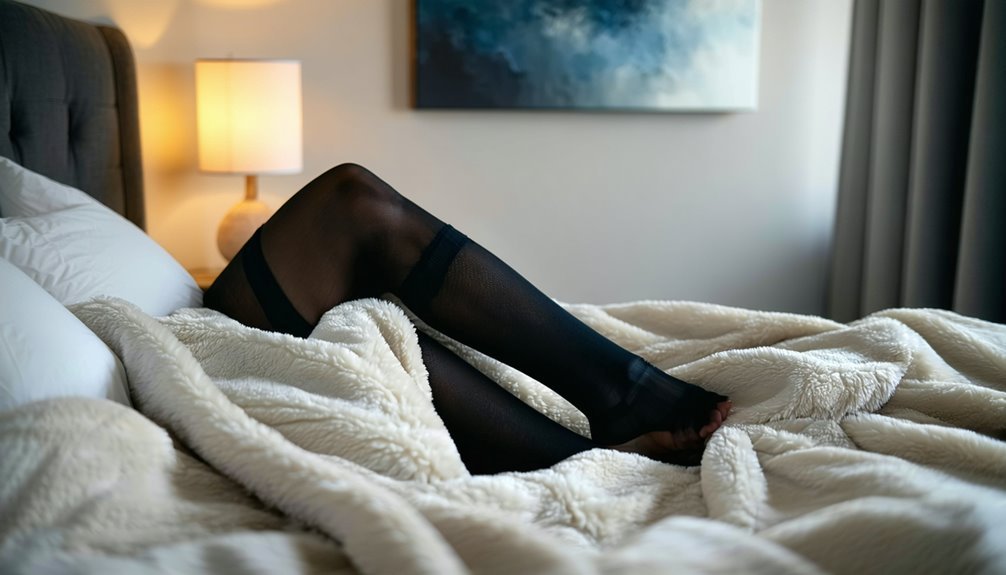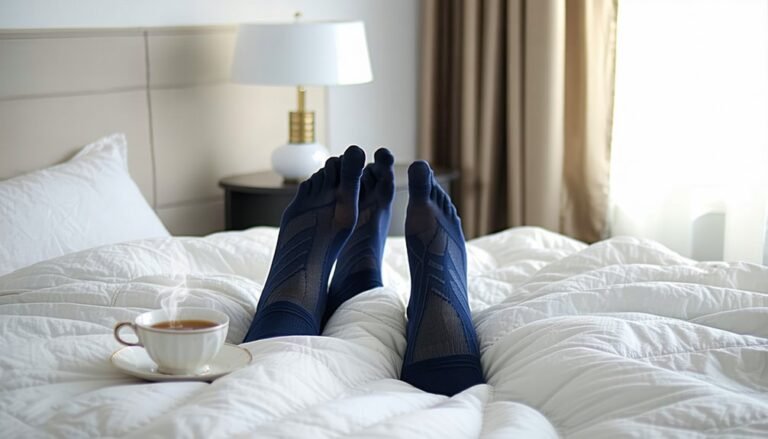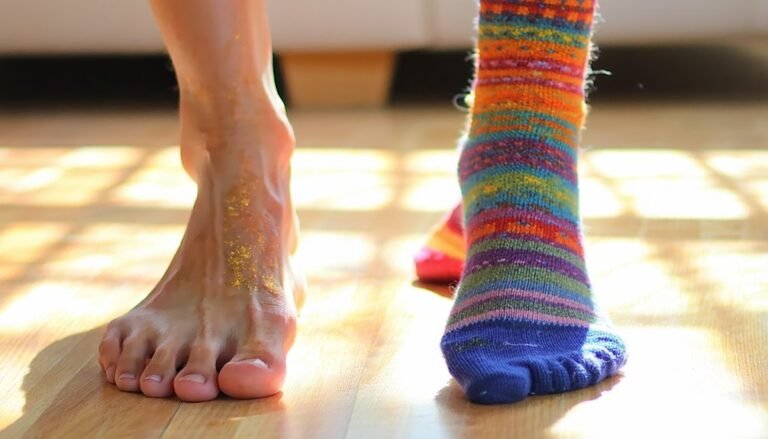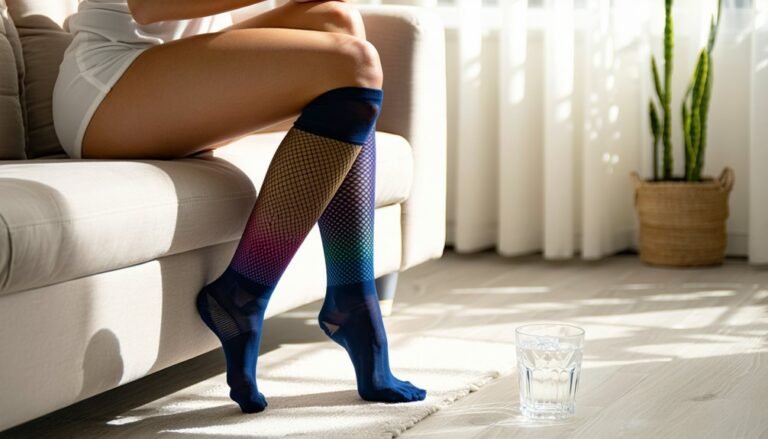Can You Sleep in Compression Socks for Restless Legs?
You can sleep in compression socks to potentially alleviate symptoms of Restless Legs Syndrome (RLS). These socks improve circulation by promoting venous return, which may reduce discomfort and leg muscle strain. It's essential to select the right size and compression level to avoid issues like circulatory problems or skin irritation. Consult a healthcare provider for personalized advice, especially if you have vascular disorders. By doing so, further insights into symptom management and comfort strategies await you.
Understanding Restless Legs Syndrome

Restless Legs Syndrome (RLS), although sometimes misunderstood, is a neurological disorder characterized by an irresistible urge to move the legs, typically accompanied by uncomfortable sensations. You're likely to experience these symptoms most intensely during periods of rest or inactivity, and they often worsen in the evening or at night, disrupting your sleep. Understanding symptom triggers is key to managing RLS effectively. Common triggers include prolonged periods of sitting, caffeine, and stress.
For treatment options, medical professionals often recommend lifestyle modifications such as regular exercise and proper sleep hygiene. Pharmacologic interventions might include dopaminergic agents, which can help mitigate symptoms. Non-pharmacologic therapies, like cognitive behavioral therapy, may also provide relief. Consulting with a healthcare provider guarantees a tailored approach to your RLS management.
How Compression Socks Work
Compression socks operate on a simple yet effective principle of graduated compression, where pressure is applied most firmly at the ankle and decreases as it moves up the leg. This design promotes ideal blood flow, enhancing venous return to the heart. By employing compression therapy, these socks exert mechanical pressure on the lower extremities, which can greatly aid in circulation improvement. The enhanced circulation helps reduce the pooling of blood, minimizes swelling, and guarantees a steady flow of oxygen-rich blood throughout your legs. In a clinical context, this therapeutic approach is backed by evidence supporting its efficacy in managing various circulatory issues. It's essential to select the appropriate compression level and size to maintain both efficacy and safety in achieving desired outcomes.
Potential Benefits of Compression Socks for RLS
When considering the potential benefits of compression socks for Restless Legs Syndrome (RLS), it's important to recognize their role in alleviating symptoms through enhanced circulation and reduced muscle tension. Evidence suggests that varied compression types can markedly improve blood flow, thereby decreasing discomfort associated with RLS. By gently applying pressure to your legs, these socks facilitate circulation improvement, which can be pivotal in managing RLS symptoms safely and effectively. Compression socks may also aid in reducing leg swelling and fatigue, further contributing to symptom relief.
| Benefit | Description |
|---|---|
| Circulation Improvement | Enhances blood flow, reducing RLS discomfort |
| Muscle Tension Reduction | Alleviates leg muscle strain and fatigue |
| Swelling Reduction | Minimizes leg swelling, enhancing comfort |
| Safe Management | Provides a non-invasive, evidence-based approach to managing RLS symptoms |
Possible Drawbacks and Considerations

While compression socks offer notable benefits, it's important to be aware of potential drawbacks and considerations. Safety concerns primarily revolve around improper fit, which can lead to circulatory issues or skin irritation. It's vital to verify the socks aren't too tight, as this could compromise blood flow. Additionally, individual comfort varies; some might find the sensation of compression uncomfortable or even distressing during sleep.
Here are a few considerations:
- Skin Sensitivity: Some individuals may experience allergic reactions to the material.
- Pre-existing Conditions: Those with vascular disorders should consult a healthcare professional before use.
- Duration of Wear: Prolonged use without breaks might lead to discomfort or exacerbate symptoms.
Careful evaluation of these factors can enhance both safety and efficacy when using compression socks.
Tips for Choosing and Using Compression Socks at Night
Selecting the right compression socks for nighttime use involves considering a few critical factors to ascertain both comfort and effectiveness. Prioritize choosing materials that are breathable and hypoallergenic to maintain skin integrity and prevent irritation. It's essential to select the correct sock sizes to guarantee ideal compression levels and avoid circulation impairment.
| Factor | Recommendation |
|---|---|
| Material | Breathable, hypoallergenic fabrics |
| Sock Size | Accurate measurement for proper fit |
| Compression Level | Consult healthcare provider for guidance |
| Seam Positioning | Seamless or flat seams to avoid pressure |
When selecting socks, consult a healthcare provider to determine the appropriate compression level. Seamless or flat seams can help prevent localized pressure points, enhancing nighttime comfort. Always follow the manufacturer's care instructions to maintain the integrity and longevity of your compression socks.
Frequently Asked Questions
Can Wearing Compression Socks at Night Improve Sleep Quality for RLS Sufferers?
Wearing compression socks at night may provide compression benefits, potentially aiding sleep improvement for RLS sufferers. Compression enhances circulation, reducing leg discomfort. Clinical studies suggest safe, evidence-based practice, though individual responses vary. Consult healthcare professionals for personalized advice.
Are There Any Side Effects of Wearing Compression Socks Overnight?
When considering compression socks overnight, weigh potential discomfort and skin irritation against benefits. Guarantee proper fit to minimize adverse effects. Evidence suggests compression can help, but always prioritize safety by consulting healthcare professionals for personalized advice and recommendations.
Do Compression Socks Help With Other Sleep Disorders Besides RLS?
Compression socks aren't typically effective for sleep apnea but can alleviate symptoms of venous insufficiency, potentially improving sleep quality. Evidence suggests they enhance circulation, reducing leg discomfort and swelling, thereby indirectly benefiting sleep for those conditions.
How Long Should One Wear Compression Socks During Sleep?
When considering compression duration during sleep, clinical guidelines suggest wearing them for 6-8 hours to maximize sleep benefits. Guarantee proper fit to prevent circulatory issues. Evidence supports their safety, but consult healthcare professionals for personalized advice.
Can Compression Socks Replace Medication for Treating RLS?
While compression socks can serve as adjunctive therapy, they're not a standalone solution. Their effectiveness varies, and they shouldn't replace medication. Consult your healthcare provider about medication alternatives for safe, evidence-based restless legs syndrome management.






